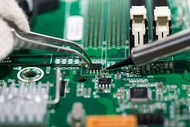3 Most Common PCB Faults and their Repairs
Posted by Staff - Soldertraining on Jan 13th 2022
In modern electronics, PCB forms the core component. It develops the layout to provide the desired mechanical connections and build the electrical connection between various components. If any of these components suffer major failure or malfunction, it can affect the equipment's functionality and performance. Circuit boards also experience wear and tear that can significantly affect them with time. The operational environment, manufacturing defects, loose connections, or other issues can cause your equipment to go down.
You can rectify the performance errors in your PCB by repairing or remanufacturing it. Rework is refinishing an operation or conducting repairs of a PCB assembly. Outsourcing printed circuit board repair services enable you to leverage professional help, tools, and processes to restore the damaged PCB board to functionality. They use the original design schematics against the faulty board to identify the underlying issue and repair it effectively.
There are various reasons why PCBs fail. The article further lists the causes for PCB failure and how to diagnose and repair it.
Physical Damage
Physical damage to a device or its internals can lead to PCB failure. A PCB board can come under physical pressure or shock, which can cause it to malfunction.
Diagnose and Repair: To remedy the physical damage sustained by the PCB board, it needs to undergo the remanufacturing process. You have to melt down the damaged sections or repair them via disassembly and reassembly. Professionals with appropriate training and experience must perform the task and repair physical damage. It requires boards remodeling, resoldering the components, and other critical tasks.
Trace Damage
The traces are the conductive pathways on the circuit board. You can see the trace damage with the naked eye. But, it may not always be visible. The trace damage affects the board's conductivity, components, and device. It may suffer trace damage due to lightning strikes, critical power surges, overheating, wear and tear, and metallic dust contamination.
Diagnose and Repair: If the trace is not excessively thin, you can identify the damage by scanning the trace pathways. The copper traces are shiny, enabling you to make out where it has suffered break or damage. Resoldering or reballing the PCB using the necessary equipment will help you rectify the damage. It allows you to reconnect the broken circuit for electricity to flow seamlessly.
Component Failure
Faulty components can cause your PCB to malfunction. Component failures may occur due to thermal, mechanical, environmental, electrical stress, packaging, and aging factors. A PCB consists of various components, such as a capacitor, diode, or microprocessor, among others. If your PCB fails to operate correctly and shows no sign of physical damage, it is almost sure that it has something to do with a faulty component.
Diagnose and Repair: If a component in your PCB fails, it is best for you to onboard professional support. Some symptoms of poor PCB components include connection issues, breaking under stress, or bending parts.
To Conclude:
These are a few common situations when your PCB requires repair services. PCBs are getting highly complex, hence creating room for malfunctioning. Thus, you need high-quality repair services to ensure that your PCB continues to operate optimally.





